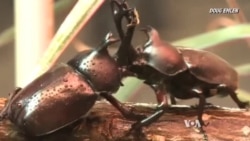In their fight for mates, food and territory, animals use the weapons they were born with - teeth and claws, horns and hooves. Human animals can use fists and feet, but we have been able to augment our arsenal with sticks and guns and bombs.
A new book by University of Montana evolutionary biologist Doug Emlen looks at the similarities between our weaponry and that of the animal world, including some armaments that reduce the likelihood of battle, and other weapons that, if they get out of hand, could end the arms race for everyone.
“Just about every animal out there has some kind of a weapon,” Emlen observed, pointing to the claws of domestic cats and dogs, and the talons of eagles.
“But when you look across animals most of the time, these weapons are pretty small. They’re lightweight, they’re portable," he said. "They don’t slow you down, they’re not very expensive to produce. But here and there, every now and then, we find these animal lineages where something has changed. And in these special species, the weapons start to get really big.”
In Animal Weapons: The Evolution of Battle, Emlen points out that those extreme weapons evolve for a reason, such as ambushing prey. The dagger-like fangs of the extinct saber toothed cat suggest that it was an ambush hunter.
The huge, heavy canine teeth made it slow and clumsy. So instead of running to catch prey, it probably lurked in trees. It waited until a mammoth walked by, then jumped onto its back and let those fangs sink in.
Specialization means some members of a species develop extreme weapons while others don't, as they evolve for other roles. That's easy to see among insects, for example. Worker ants are small and quick. But the soldier ants that guard the colony have incredibly powerful jaws.
Most of these extreme weapons are on the male of the species, and Emlen notes that duels are the most common driver of their development, from the enormous antlers of elks, to the huge claws of tiny fiddler crabs.
“Fiddler crabs are actually, as far as we know, the most extreme animal weapon anywhere. In some of the most extreme cases, the biggest males of these fiddler crab populations produce a claw that is literally the entire weight of the rest of the body of the male.”
The biggest “claw” almost always wins. But usually, Emlen said, its main point is communication, to avoid battle.
“The males can go right up to an opponent, they wave their claws, they size each other up, and the smaller male walks away. And so this odd sort of paradox that arises in these animal species with these huge weapons is a lot of times, they hardly ever fight,” said Emlen.
Writing in Animal Weapons, Emlen said in some ways, humans are no different. Take the U.S. military... where size matters.
“Our aircraft carriers absolutely work as deterrents,” he pointed out. “There aren’t any other countries that have navies as big as the one the United States has for example today, and we use those aircraft carriers as deterrents.”
But this is where human behavior veers in a direction that Emlen said is incredibly dangerous, at least in terms of the natural world he studies. Our most powerful weapons now are widely available. If everyone has a bomb, Emlen asks, how can rivals size each other up and know when to back down?
He says there is no analogy in the animal kingdom for weapons of mass destruction. And because these could destroy the world, he hopes all nations will take a lesson from the natural world.












